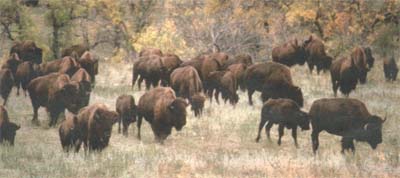|
|
Belovezhskaya Pushcha is the oldest national Park of Europe situated in Western part of Belarus within Grodno and Brest provinces (70 km away from Brest and 30 km away from Kamenets) along the state border with Poland and partially on the territory of Poland. Name of the park comes from the name of Belovezha Castle ("belo" means "white" and "vezha" means "tower" in Polish and Belorussian languages) situated in Poland. Nowadays the national park occupies the area of 85 thousands hectares stretching from North to South for 65 km and from West to East for 10 to 30 km. Once the area was reserved exclusively for hunting for Polish kings (1410-1794) and Russian tsars (1794-1914). Nowadays Belovezhskaya Pushcha withing territory of Belarus possesses status of national park.

Climate and soil conditions of the territory are favorable for development of trees and shrub plants amounting up to 900 species. Vegetations period is about 200-210 days. Annual precipitation is about 670 mm mostly during the vegetation period. Snow covers ground approximately 70 days a year.
86% of the area of Belovezhskaya Pushcha is covered by woods with coniferous forests prevailing (56%). The age of trees ranges up to 160-180 years while their heights amount up to 32-35 meters. Sometimes you can find true record breakers: 200 to 350 years old pine trees with trunk diameter of up to 150 cm (60 inches). 11.4% of the area is covered with fir-woods. By the way, it is a fir-tree that is the highest species of Belavezhskaya Pushcha forests. Some of fir-trees reach 50 meters (165 feet) in height. Birch woods comprise 10.5% of the total area of the park while aspen trees are less common. Woods of oak-trees occupy 3.7% of the total forest area. Mostly oak trees are aged of 170 to 200 years however sometimes gigantic elders of 300 to 500 years old with trunks of two meters in diameter can be found. Banks of rivers and water-meadows are trimmed with hazel nut-trees, while heights are usually covered with maples and ash-trees as well as with undergrowth of hazel nut, buck-thorn, strawberry and black currant bushes. Belovezhskaya Pushcha is extremely reach in herbaceous plants.
Belovezhskaya Pushcha is the only forest tract in Europe remaining actually intact. Variety of flora and mild climate (average annual temperature is about +7.4°C) form favorable conditions for life of forest animals. Here live 55 species of mammals, more than 200 species of birds, 11 species of amphibia, 7 species of reptiles. However, the most remarkable wild animal of the park - and the biggest one in Europe - is European bison called "zubr" in Belorussian.
Early in the 19th century Belovezhskaya Pushcha was the only point on the map of Europe where bisons continued to live as on the rest of the territory of Europe they were actually exterminated. The law of 1803 banned hunting bisons. There were organized feeding bisons and exterminating the predators dangerous for them. Immediate results followed the undertaken measures. According to official data as soon as in 1824 live-stock of zubrs reached 500 animals, in 1830 - 700, in 1840 - 817, in 1850 - 1560, in 1860 - 1575. However, starting from the 60s of the 19th century the live-stock of zubrs began to reduce again so that by 1910 they numbered a mere 700 animals. Shortly before that bisons could be found in the forests of Western, Central Europe and in the Caucases as well, however by the early 20th century they remained in Belovezhskaya Pushcha and in the upper reaches of the Kuban River (North Caucases) only.
During World War I destraction of the population of the rare animals began. Last bison of Belovezhskaya Pushcha was shot in 1921 while last Caucasian one was killed in 1927. Two years later, in 1929, some bisons from European zoos were brought to the park. By the beginning of World War II there were 19 animals in the park yet some of them were killed during military actions. In post-war period the restoration of the live-stock began. As a result of protection of the animals and some other bio- and technical measures the number of bisons increased up to 70 during next twenty years.
You can easily find wild boars through out Belovezhskaya Pushcha. There live also wolves, lynxes, polecats and ferrets, weasels, foxes, martens, ermines, raccoons and other forest inhabitants. Beavers and otters dwell along rivers and forest brooks while old woods swarm with hares. Fir woods are rich in squirrels. The most numerous rodents are mice whereas the most common insectivorous are moles and shrews.
The world of birds in Belovezhskaya Pushcha is even more various and rich. Along with typical western species (for example, red kite or canary finch) here you can find Sibirian species (three fingered woodpecker, long tailed tawny owl) as well as birds of North deciduous forests (green woodpecker). Furthermore, there are more than 20 species of predatory birds, plenty of wood game. Various hazel-hens are especially numerous in Pushcha. It is the very place where most of the capercailzies living in the country are concentrated, where black storks build their nests and some pheasants have been brought to breed.
In short, you can see a lot in Belovezhskaya Pushcha. By the way, for visitors there is a museum with a lot of interesting - things exhibited such as paintings with episodes îf medieval hunting, stuffed animals from Pushcha and others. For those who are hungry there is a restaurant with exotic dishes. A lot of species living in Belovezhskaya Pushcha are kept for visitors in special hedged areas and cages. So you can enjoy the landscapes with bisons, elks, wild boars, volves, foxes, bears and so on as long as you wish.
|
|